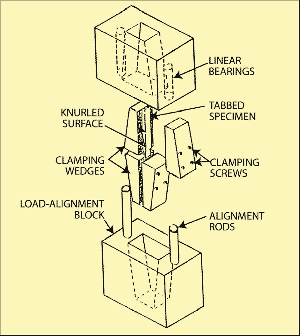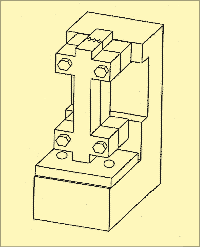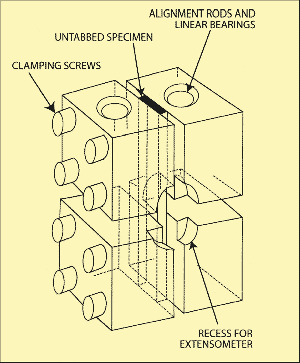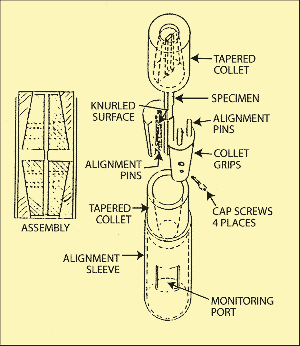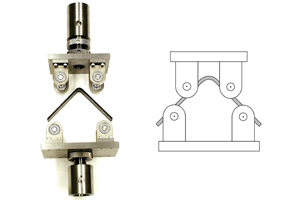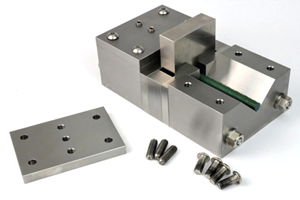Current compression test methods
Dr. Don Adams discusses the test methods and fixtures currently available to test the compressive strength of composites.
|
Until the mid-1970s, compression testing of composite materials received relatively little attention. Up to that point it, had generally been assumed that the compressive stiffness was approximately equal to the tensile stiffness (which is still a reasonable assumption), and thus tensile stiffness testing was adequate. However, the industry soon realized that a similar assumption regarding compressive strength was definitely not valid. The compressive strength of many composites, when measured, appeared to be significantly lower than the tensile strength. This was of particular concern at the time since composites were being designed for use in the upper wing skins of aircraft, a compression strength-critical application. Unfortunately, test methods for measuring the compressive strength of the high-performance composites then in use were not well developed. In fact, the first ASTM standard specifically written for the compression testing of composite materials (viz., ASTM D 34101) was not issued until 1975. It standardized the so-called Celanese compression test method (Fig. 1) developed by the Celanese Corp. in the early 1970s2. This method required the use of a tabbed specimen of precise thickness, gripped between split cones. The shortcomings of this test method soon became apparent. Unless the specimen was accurately prepared and the test carefully performed, the results were likely to be erratic. |
|
In response, the Illinois Institute of Technology Research Institute (IITRI) soon developed a radically modified compression test fixture3 (Fig. 2). It was designed to eliminate, or at least minimize, the major deficiencies of the Celanese fixture. Unfortunately, it was designed as a very large fixture, and thus was both heavy and expensive to fabricate. For example, the Celanese fixture weighs approximately 10 lb, whereas the IITRI fixture weighs about 95 lb. Such a heavy fixture is not very popular with laboratory technicians. And while the fabrication cost of the Celanese fixture, due to its complexity, was high relative to other types of fixtures, the cost of the IITRI fixture was about twice as high. That is, both fixtures were expensive. |
|
As a result, in part, of these nontechnical considerations, it was not until 12 years later, in 1987, that the IITRI test method was added to ASTM D 3410, as Method B. Incidentally, a Method C also was added at the same time, viz., a flexural test of a sandwich beam with the test coupon being the face sheet on the compressive surface of the beam. In 1993, this seldom-used Method C was removed to its own standard, ASTM D 54674, where it still languishes today. The Celanese method was then deleted in 2003, so that presently ASTM D 3410 contains only the IITRI method. During the early 1980s, The Boeing Co. (Seattle, Wash.) along with Hercules Inc.5 radically modified an existing test method, ASTM D 695, which had been developed over 40 years earlier primarily for testing unreinforced plastics (as the title indicates)6. The principal modification was to replace the untabbed, dog-boned specimen with a tabbed, straight-sided specimen (Fig. 3). This was a major change, of course, actually making it a new test method, even though it is usually referred to as the Modified D 695 or Boeing Modified D 695 test method. (It should be noted that this modification has never been adopted by ASTM.) |
|
The Celanese and IITRI compression test methods are shear-loaded specimen configurations, whereas the Modified D 695 test method uses end-loading. It is thus logical to attempt to combine the best aspects of these two loading methods. A major research effort at the University of Wyoming7,8,9 during the 1990s finally led to the development of ASTM Standard D 6641, the Combined Loading Compression (CLC) Test Method (Fig. 4), first issued in 200110. |
|
Various comparison studies over the years have indicated that if each of these test methods is conducted properly, comparable results can be obtained8,11. This leads to the logical question, Which compression test method should I use? As previously noted, the Celanese method, because of its deficiencies, has now been dropped from ASTM D 3410, making its future clear. The Sandwich Beam method, now ASTM D 5467, has never been very popular. It uses a relatively large sandwich beam specimen, which requires special skills and equipment to fabricate, and each beam consumes considerable test material. The IITRI method (ASTM D 3410) was very popular in the 1990s, but is now used much less frequently. Certainly both fixture cost and weight have been negative factors. The Modified D 695 method, also commonly used during the 1990s, is now fading. Opposite to the IITRI fixture, its low cost, low weight (less than 4 lb), and ease of use has helped maintain some popularity. However, because of buckling considerations, the standard specimen incorporates a very short gage length (4.8 mm/0.188 inch) between tabs, selected since originally very thin specimens were used (typically 1 mm/0.040-inch thick). This limited gage length does not permit the use of strain instrumentation. A separate, untabbed specimen must be tested if modulus is to be determined, effectively doubling the cost of the testing. And if a thicker specimen is used, to permit a longer gage length, end crushing or tab debonding of this end-loaded specimen becomes even more of a problem. Meanwhile, use of the Combined Loading Compression test method is increasing rapidly. The fixture is relatively small (10 lb) and inexpensive, easy to use and favorably combines loading modes. This often permits the use of simple untabbed, straight-sided specimens, and very reliable results are usually obtained. Thus, it appears very likely that the Combined Loading Compression test method, ASTM D 6641, will be the eventual sole survivor among the current compression test methods. Of course, this elimination process is evolutionary rather than revolutionary, as evidenced by the long timeline traced here. Thus, at least some of the other test methods discussed here, and their various modifications, will be around for many years to come. Editor's note: Dr. Adams discusses the evolution of the ASTM D 695 Compression Test Method in the column listed under "Editor's Picks," at right. References 1 ASTM Standard D 3410-03, "Compressive Properties of Polymer Matrix Composite Materials with Unsupported Gage Section by Shear Loading," ASTM International, W. Conshohocken, Pa., 2003 (first issued in 1975). 2 I.K. Park, "Tensile and Compressive Test Methods for High-Modulus Graphite Fibre-Reinforced Composites," Proceedings of the International Conference on Carbon Fibres, Their Composites and Applications, Paper No. 23, The Plastics Institute, London, 1971. 3 Hofer, K.E., Jr., and Rao, P.N., "A New Static Compression Fixture for Advanced Composite Materials," Journal of Testing and Evaluation, Vol. F, No. 4, July 1977, pp. 289-283. 4 ASTM D 5467-97, "Compressive Properties of Unidirectional Polymer Matrix Composite Materials Using a Sandwich Beam," ASTM International, W. Conshohocken, Pa., 1997 (first issued in 1993). 5 Abdallah, M.G., "State of the Art of Advanced Composite Materials: Compression Test Methods," JANNAF, CMCS and SAMS Joint Meeting, Jet Propulsion Laboratory, Pasadena, Calif., November 1984. 6 ASTM Standard D 695-02a, "Compressive Properties of Rigid Plastics," ASTM International, W. Conshohocken, Pa., 2002 (first issued in 1942). 7 Adams, D.F., and Welsh, J.S., "The Wyoming Combined Loading Compression (CLC) Test Method," Journal of Composites Technology & Research, Vol. 19, No. 3, July 1997, pp. 123-133. 8 ASTM Standard D 6641-01, "Determining the Compressive Properties of Polymer Matrix Composite Laminates Using A combined Loading Compression (CLC) Test Fixture," ASTM International, W. Conshohocken, Pa., 2001 (first issued in 2001). 9 Adams, D.F., "Current Status of Compression Testing of Composite Materials," Proceedings of the 40th International SAMPE Symposium, Anaheim, Calif., May 1995. 10 Welsh, J.S., and Adams, D.F., "Unidirectional Composite Compression Strengths Obtained by Testing Mini-Sandwich, Angle-, and Cross-Ply Laminates," Report UW-CMRG-R-95-106, Composite Materials Research Group, University of Wyoming, Laramie, Wyo., April 1995. 11 Wegner, P.W., and Adams, D.F., "Compressive Properties of Composite Laminae Using the Wyoming Combined Loading Compression (CLC) Test Fixture," Report UW-CMRG-99-101, Composite Materials Research Group, University of Wyoming, Laramie, Wyo., January 1999. |
Related Content
Interlaminar tensile testing of composites: An update
New test method developments for measuring interlaminar tensile strength address difficulties associated with the ASTM D6415 curved beam flexure and ASTM D7291 flatwise tensile tests.
Read MoreCrashworthiness testing of composites: A building block approach, Part 1
Determining the crashworthiness of composite structures requires several levels of testing and analysis, starting with coupon-level crush testing.
Read MoreCrashworthiness testing of composites: A building block approach, Part 2
Following the previously discussed coupon-level testing element, subcomponent and component testing are the next steps in designing crashworthy composite structures.
Read MoreComposite test methods (and specifications) for fiber-reinforced concrete structures
While initially focused on transitioning existing standards published by the American Concrete Institute, the relatively new ASTM Subcommittee D30.10 is developing new standardized test methods and material specifications for FRP composites.
Read MoreRead Next
VIDEO: High-volume processing for fiberglass components
Cannon Ergos, a company specializing in high-ton presses and equipment for composites fabrication and plastics processing, displayed automotive and industrial components at CAMX 2024.
Read MoreDeveloping bonded composite repair for ships, offshore units
Bureau Veritas and industry partners issue guidelines and pave the way for certification via StrengthBond Offshore project.
Read MorePlant tour: Daher Shap’in TechCenter and composites production plant, Saint-Aignan-de-Grandlieu, France
Co-located R&D and production advance OOA thermosets, thermoplastics, welding, recycling and digital technologies for faster processing and certification of lighter, more sustainable composites.
Read More



